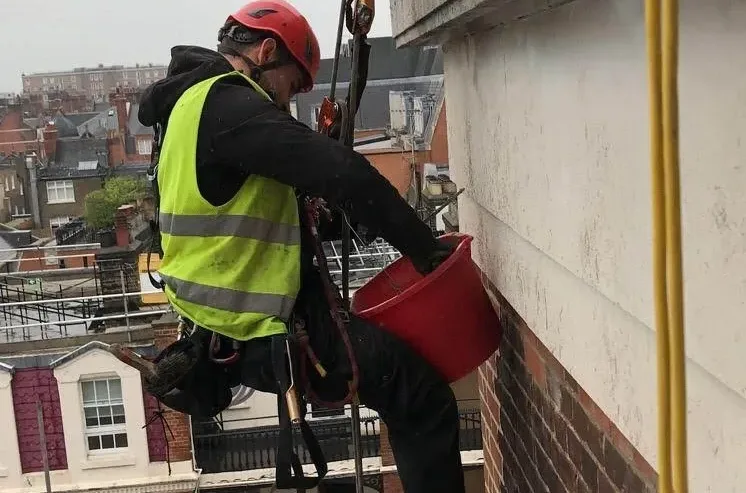
Introduction
Maintaining high-rise buildings and other hard-to-reach structures requires specialized work-at-height methods. The two primary options are rope access (industrial abseiling) and scaffolding. Rope access solutions involve skilled technicians descending or climbing on ropes to reach the work area, whereas scaffolding uses temporary steel structures assembled around the building. Each method has its advantages and considerations. Rope access is known for being one of the least invasive and extremely safe access methods, often requiring no additional ground space and minimal setup time. Scaffolding, on the other hand, provides a stable platform for workers and materials but can be labor-intensive to install and more disruptive to the property. For property managers and building owners – especially in dense urban environments like London – understanding the differences in cost, safety, and efficiency between scaffolding and rope access is crucial when planning high-rise maintenance or facade work. Below, we compare these methods to help construction professionals evaluate the best work-at-height solution for their project.
Cost Comparison
When it comes to cost, rope access often has a clear edge over scaffolding. The upfront costs for scaffolding include purchasing or renting large quantities of scaffolding materials, transporting them to site, and paying a crew to construct and later dismantle the scaffold. These expenses add up quickly, especially for tall or complex structures that require extensive coverage. Rope access, by contrast, requires far less equipment and manpower – typically just a team of certified technicians with ropes and harnesses. This lean setup translates into significant savings on labor and materials. In fact, the combined cost of erecting, renting, and removing a scaffold often outweighs the cost of hiring a small rope access team. Some building maintenance companies report that using rope access can cut property repair costs by up to 40% compared to scaffolding.
- Setup & Equipment: Scaffolding requires purchasing or renting modular frames, planks, ties, and safety netting. Installation must be done by skilled scaffolders and can take days or weeks, incurring heavy labor costs. Rope access setup is minimal – technicians install a few anchor points and ropes – and they can often begin work within a couple of hours of arriving on site. Less equipment and faster setup mean lower initial costs.
- Labor: A scaffolding project might need a large crew working multiple days to build and later remove the structure. These labor costs accumulate for the entire duration the scaffold is up (plus many scaffolding companies impose minimum rental periods). Rope access uses a small team whose labor is needed only for the actual task at hand, not days of setup and teardown. This efficiency can significantly reduce total billed hours.
- Maintenance & Duration: If scaffolding remains up for long periods (common in extensive renovations), there are ongoing costs: inspections, maintenance of the scaffold, and possibly security or lighting for the structure. Rope access is typically used for shorter-duration tasks – once the job (e.g. window glazing replacement or facade inspection) is done, the ropes come down. There are no prolonged rental fees. One real-world example cited a roof repair project where using rope access in place of scaffolding saved over £100,000 in project costs. Such savings make rope access very attractive for building owners watching the bottom line.
It’s worth noting that scaffolding may still be cost-effective for certain scenarios (we will discuss those later), but for many maintenance and repair jobs, the leaner approach of rope access offers clear cost advantages. Especially for very tall buildings, scaffolding costs rise with each additional floor, whereas rope access costs remain relatively flat (mostly the labor of technicians). Many property developers find rope access to be the more affordable option for high-rise maintenance as a result.
Safety Comparison
Safety is a paramount concern in any work-at-height scenario. At first glance, seeing technicians dangling on ropes might seem more perilous than standing on a scaffold, but the statistics and protocols tell a different story. Rope access has an impressive safety record, often cited as one of the safest methods for high-angle work. Technicians undergo rigorous training and certification (such as IRATA or SPRAT) to ensure they adhere to strict safety protocols. They always work in pairs or teams, and each technician is secured by at least two ropes – a main working line and a secondary backup line – anchored independently. This redundancy means that even if one rope fails (an extremely rare occurrence), there is a fail-safe in place. Additionally, rope access tools and equipment are tethered to the technician or the harness at all times, so there is minimal risk of dropping objects on people below. Thanks to this focus on control measures and training, rope access work has a low incidence of accidents relative to other construction activities.
Scaffolding work also follows safety regulations (in the UK, scaffolds must be erected by certified professionals and regularly inspected). When properly installed, scaffolding provides a stable platform with guardrails, which can be very safe for workers moving around at height. However, scaffolding introduces a different set of risks. The presence of a large physical structure means there is potential for structural failures or collapses (especially if overloaded or if setup on unstable ground). Objects (tools, debris) can be accidentally knocked off a scaffold, and without a tethering requirement in all cases, they pose a hazard to those below. In one incident, a pedestrian was killed by a tape measure dropped from a high scaffold – highlighting the danger of unsecured tools. Scaffolds are also exposed to environmental factors: high winds can weaken ties or even cause partially built scaffolding to sway or fall.
Worker training is another differentiator. Rope access crews are highly specialized in work-at-height safety and rescue techniques, continuously supervised under strict guidelines. In contrast, a larger variety of tradespeople may use a scaffold (painters, electricians, masons, etc.), and not all will have the same level of height-safety training as dedicated rope professionals. Thus, the onus is on scaffold supervisors to enforce hard hats, harnesses on tall scaffolds, toe boards, regular inspections, and other safety measures to prevent accidents.
In summary, rope access safety is maintained by intensive training, dual-rope systems, and careful procedural controls, yielding a strong safety record and minimizing risks to workers and the public. Scaffolding safety can be very good as well, but when failures happen, they tend to be more catastrophic (a collapsed scaffold or a dropped item from height). Both methods require adherence to work-at-height safety regulations, but rope access by design builds in multiple layers of protection (often exceeding standard work-at-height safety requirements). For building owners, this means rope access can be trusted for tasks like high-rise window cleaning or facade repairs with a high degree of confidence in safety.
Efficiency & Flexibility
Beyond cost and safety, a key consideration is how efficient and flexible each method is in completing the work. This includes how quickly the system can be deployed, how easily it adapts to the building’s geometry, and how much it disrupts the surroundings. Here, rope access often outperforms scaffolding by a wide margin.
Setting up scaffolding is a time-consuming process. For a multi-story building, it might take a crew several days or even weeks to fully assemble the scaffold tower around the work area. Only after it’s built can the actual maintenance or construction work begin. Dismantling the scaffold at the end of the project adds additional days to the schedule. Rope access, in contrast, has minimal setup – technicians can often mobilize and be working on the building the same day they arrive. There’s no need to transform the site into a construction zone for access; they simply rig ropes at a secure anchor point (often the roof or an exposed structural element) and start the task. This agility makes rope access ideal for quick repairs or tight project timelines. If an inspection or urgent fix is needed on a high-rise, waiting a week for scaffolding would be impractical – a rope access team can tackle it almost immediately.
Flexibility is another strong suit of rope access. Because technicians on ropes can traverse the facade freely, they can reach nearly any point on a building exterior, even awkward or confined areas, without needing additional structures. They can move up, down, and sideways by repositioning ropes or using ascenders/descenders, giving them access to places that might be impossible to scaffold (for example, undersides of bridges, domed roofs, spires, or interior atriums). Rope access also isn’t constrained by ground space – it doesn’t require a flat, open area at the base of the building for equipment. This is a huge advantage in dense city environments. In downtown London or any busy city, erecting scaffolding might require blocking part of a sidewalk or street, obtaining permits, and causing inconvenience to pedestrians. Rope access is performed mostly with roof rigging, so it minimizes ground-level disruption. Building entrances can often remain open, and there’s no large structure obscuring the facade or the view from inside offices/apartments.
Scaffolding is inherently less flexible in terms of positioning – it can only give access where it is built. If you need to reach a different section of the building, the scaffold has to be extended or reconfigured. By design, scaffolds are also constrained by the building’s architecture: extensive projections, very irregular facades, or fragile historic surfaces might prevent attaching a scaffold safely. There are workarounds (such as suspended scaffolds from roofs, or custom-designed supports), but these add complexity and cost. Scaffolding also occupies space: it’s bulky and will cover the building’s exterior with steel poles and planks (often wrapped in mesh for safety, as shown above). This can turn the building essentially into a construction site for the duration of work. In contrast, rope access keeps the building largely open and operational while work is ongoing. Tenants or employees inside might only notice a few ropes and the technicians descending; there’s no need to shut down windows or cover entire facades for months.
In terms of speed of work, rope access can be extremely efficient for many types of maintenance. For example, rope technicians can rappel down a high-rise cleaning windows or caulking joints continuously, floor after floor, much faster than a scaffold platform might be moved or a swing stage repositioned. However, scaffolding can be more efficient for certain large-scale tasks once it’s in place – workers have a stable platform to carry and leave tools, multiple crew members can work side by side on a broad section of wall, etc. So for projects like repainting an entire building or re-cladding a facade, a scaffold might allow for more workers simultaneously on the job. But if we consider the total project timeline including access setup and teardown, rope access often still finishes sooner for moderate-size tasks. One source notes an “undeniable speed advantage” with rope access: what takes weeks with scaffolding might be done in days via ropes.
To summarize efficiency and flexibility: Rope access offers rapid deployment, minimal site impact, and the ability to reach almost any location on a structure with ease. Scaffolding provides a wide work platform and can accommodate heavy loads or many workers at once, but at the cost of lengthy preparation and less adaptability. In many cases – such as routine high-rise maintenance, inspections, or repairs – the quick, nimble approach of rope access is far more efficient in both time and labor. Scaffolding tends to be reserved for when the job itself demands the kind of access only a full platform can provide.
When to Choose Each Method
Both rope access and scaffolding have their place in building maintenance and construction. The optimal choice depends on the specifics of the project: the type of work, the building’s characteristics, the project duration, and even the surrounding environment (e.g., urban vs. open space). Below are scenarios outlining when each method is most suitable:
Rope access is ideal when:
- Short-term or Quick Tasks – For inspections, surveys, and one-off repairs (like fixing a leaky facade panel or replacing a broken window), rope access allows technicians to get the job done immediately without waiting on extensive setup. If an issue needs prompt attention, a rope team can often complete the work in the time it would take just to install a scaffold.
- Tall or Complex Structures – On very high buildings (skyscrapers, towers) or structures with complex geometry, scaffolding becomes extremely expensive and impractical. Rope access remains feasible and cost-effective regardless of height, since technicians can descend from the roof and don’t need ground-based support. Many high-rise building owners choose rope access solutions for tasks like curtain wall repairs or high-rise maintenance because the cost of scaffolding “increases as the height does” whereas rope access does not.
- Minimal Disruption Required – If the building is occupied or located in a busy area (think building maintenance in London on a crowded street), rope access is preferred to avoid major disruptions. It won’t block entrances or sidewalks and doesn’t alter the building’s appearance with a metal exoskeleton. Property managers often opt for rope access on hotels, office buildings, or apartments where maintaining normal operations and views is important.
- Difficult Access Areas – Some parts of a structure are nearly impossible to reach with a scaffold (underside of a bridge deck, inside an atrium roof, spires, industrial chimneys). Rope access technicians excel in these situations, using ropes to reach places a scaffold can’t without enormous effort. Their ability to adapt to challenging angles and confined spaces makes rope access the go-to method for many rope access solutions in industrial maintenance and confined space work.
- Specialized Technical Work – Rope access is often the method of choice for specialized high-angle work like telecom tower maintenance, wind turbine blade repairs, or cliff-side rockfall mitigation – tasks where building a scaffold would be infeasible. In urban building contexts, this might include installing bird netting on high ledges, applying waterproofing to a tricky spot, or cleaning windows on a twisting modern facade. Rope access technicians can perform these with precision and leave as soon as the job is done, saving time and costs for the building owner.
Scaffolding is preferable when:
- Long-Duration or Large-Scale Projects – If a project will span many weeks or months (such as a major facade restoration, painting an entire building, or extensive structural repairs), a scaffold’s stable platform can improve productivity. Workers can perform tasks at their own pace with all tools at hand, without the daily setup of ropes. For example, during a full facade refurbishment every 10-15 years (common for large condominiums), it’s typical to cover the entire building in scaffold and mesh for 3-5 weeks to allow thorough work on all areas. The initial scaffold investment pays off over a long project timeline.
- Heavy Construction & Load Requirements – Some jobs involve installing heavy materials or large components at height – think of replacing many large windows, erecting steel beams, or rebuilding masonry. Scaffolding is designed to carry significant loads (workers, equipment, and materials), whereas rope access has practical limits on what a technician can haul up or down. According to engineering experts, many construction tasks that involve heavy loads or extensive manual work are difficult or impossible with rope access alone. In these cases, a scaffold or a powered platform is necessary to safely support the work.
- Multiple Trades or High Manpower Needs – If the project requires a crew of dozens spread out over a facade (painters, carpenters, etc. working simultaneously), scaffolding provides the space and access for everyone. It’s essentially an extension of the building, enabling a whole team to work side by side or on multiple levels at once. Rope access typically involves a smaller number of technicians working in a limited area at any given time. So for complex projects where you want, say, electricians, welders, and painters all attending to different tasks on the building exterior concurrently, a scaffold is the more practical choice.
- Continuous Access – When workers need to frequently go back and forth to a location or perform repeated trips with tools/materials, a scaffold offers continuous access. An example is tuckpointing or brick replacement on a facade: a mason might prefer a scaffold where they can stand, use both hands freely, and have bricks and mortar right next to them. Rope access would slow such a task because the technician must carry limited materials on the harness and cannot work as ergonomically on a vertical rope. In essence, tasks that benefit from a platform work environment (stable footing, tool storage, easy movement) are better suited to scaffolding.
- Regulatory or Structural Constraints – In some cases, local regulations might limit rope access usage (for instance, some jurisdictions require special permission to use rope descent systems on very tall buildings, or a building may lack certified anchor points which are legally required for rope work). If a building’s roof cannot support the anchors or there are no viable tie-in points, scaffolding might be the only safe way to reach the work area. Similarly, on certain historic buildings, conservation officers might require scaffolding to protect the structure or to allow very careful examination of the facade (though rope access is also used on historic buildings to avoid contact – it depends on the philosophy of the project).
In practice, the decision may also involve a combination of methods. It’s not uncommon on large projects to use scaffolding on some elevations of a building and rope access on others, depending on what is being done where. Mobile Elevated Work Platforms (cherry pickers, boom lifts) are another alternative or complement for certain heights, though they have their own limits. The key for building owners and construction professionals is to evaluate the scope of work: if it is highly localized, short-term, or requires agility – rope access is usually the smart choice. If it’s broad, heavy-duty, or extended – scaffolding (or a mix of scaffold and rope for different phases) might be justified. Consulting with work-at-height experts can help determine the most efficient approach for each specific scenario.
Conclusion
Choosing between rope access and scaffolding ultimately comes down to balancing cost, safety, and efficiency for the task at hand. For many modern maintenance needs – such as high-rise window cleaning, facade inspections, leak repairs, and other maintenance in a city environment – rope access provides a fast, cost-effective, and safe solution. It minimizes disruption to tenants and the public and can be deployed with agility, which is why rope access has grown so popular for building maintenance in London and other metropolitan areas with numerous tall buildings. Scaffolding remains an invaluable method for cases where extensive work must be done at height over long periods, or where the nature of the job demands a full platform and heavy equipment. It’s the traditional choice for large construction or restoration projects and still the best option in those circumstances.
Property managers and building owners should consider the scale and requirements of their project: if you need a few technicians to swiftly address maintenance on a skyscraper, rope access is likely the superior choice; if you’re undertaking a complete exterior overhaul, scaffolding might be worth the investment despite the higher cost and longer setup. Often, the recommendation is to leverage rope access wherever possible for its efficiency and bring in scaffolding only when necessary for extensive works. By doing so, one can achieve the required results while keeping budgets in check and maintaining high work-at-height safety standards.
In the end, both methods have proven their value. Rope access vs scaffolding is not a matter of which is universally better, but which is better for your specific project. By understanding the comparative advantages in cost, safety, and flexibility outlined above, decision-makers can confidently choose the appropriate work-at-height solution. Embracing the right method will ensure that high-rise maintenance and building projects are completed smoothly, safely, and cost-effectively – whether that means a team of rope access professionals hanging on the side of a skyscraper or a scaffold rising along the building’s facade. The goal is the same: a successful project and a well-maintained, safe property. With careful evaluation, one can achieve the optimal balance and get the job done with minimal fuss at height.



